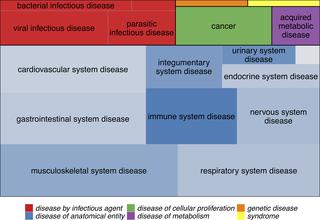PLOS ONE ( IF 3.7 ) Pub Date : 2020-03-31 , DOI: 10.1371/journal.pone.0230884 Brooke Rhead 1, 2 , Xiaorong Shao 1 , Hong Quach 1 , Poonam Ghai 3 , Lisa F Barcellos 1, 2 , Anne M Bowcock 3, 4

|
Endothelial cells are a primary site of leukocyte recruitment during inflammation. An increase in tumor necrosis factor-alpha (TNFa) levels as a result of infection or some autoimmune diseases can trigger this process. Several autoimmune diseases are now treated with TNFa inhibitors. However, genomic alterations that occur as a result of TNF-mediated inflammation are not well understood. To investigate molecular targets and networks resulting from increased TNFa, we measured DNA methylation and gene expression in 40 human umbilical vein endothelial cell primary cell lines before and 24 hours after stimulation with TNFa via microarray. Weighted gene co-expression network analysis identified 15 gene groups (modules) with similar expression correlation patterns; four modules showed a strong association with TNFa treatment. Genes in the top TNFa-associated module were all up-regulated, had the highest proportion of hypomethylated regions, and were associated with 136 Disease Ontology terms, including autoimmune/inflammatory, infectious and cardiovascular diseases, and cancers. They included chemokines CXCL1, CXCL10 and CXCL8, and genes associated with autoimmune diseases including HLA-C, DDX58, IL4, NFKBIA and TNFAIP3. Cardiovascular and metabolic disease genes, including APOC1, ACLY, ELOVL6, FASN and SCD, were overrepresented in a module that was not associated with TNFa treatment. Of 223 hypomethylated regions identified, several were in promoters of autoimmune disease GWAS loci (ARID5B, CD69, HDAC9, IL7R, TNIP1 and TRAF1). Results reveal specific gene groups acting in concert in endothelial cells, delineate those driven by TNFa, and establish their relationship to DNA methylation changes, which has strong implications for understanding disease etiology and precision medicine approaches.
中文翻译:

TNFa刺激前后,内皮细胞的整体表达和CpG甲基化分析揭示了富含炎性和传染性疾病及相关DMR的基因模块。
内皮细胞是炎症过程中白细胞募集的主要部位。由于感染或某些自身免疫性疾病导致的肿瘤坏死因子-α(TNFa)水平升高可以触发此过程。现在已经用TNFa抑制剂治疗了几种自身免疫性疾病。然而,由于TNF介导的炎症而发生的基因组改变尚不清楚。为了研究由增加的TNFa产生的分子靶标和网络,我们通过微阵列在TNFa刺激之前和之后24小时测量了40个人脐静脉内皮细胞原代细胞系中的DNA甲基化和基因表达。加权基因共表达网络分析确定了15个具有相似表达相关模式的基因组(模块)。四个模块显示与TNFa治疗密切相关。与TNFa相关的模块中最上端的基因均被上调,甲基化区域的比例最高,并且与136种疾病本体论术语相关,包括自身免疫/炎症,感染性和心血管疾病以及癌症。它们包括趋化因子CXCL1,CXCL10和CXCL8,以及与自身免疫性疾病相关的基因,包括HLA-C,DDX58,IL4,NFKBIA和TNFAIP3。心血管疾病和代谢疾病基因,包括APOC1,ACLY,ELOVL6,FASN和SCD,在与TNFa治疗无关的模块中被过度表达。在鉴定出的223个低甲基化区域中,有几个位于自身免疫疾病GWAS基因的启动子中(ARID5B,CD69,HDAC9,IL7R,TNIP1和TRAF1)。结果显示,特定基因组在内皮细胞中起协同作用,描绘了由TNFa驱动的基因组,并建立了它们与DNA甲基化变化的关系,这对理解疾病病因和精确医学方法具有重要意义。


























 京公网安备 11010802027423号
京公网安备 11010802027423号